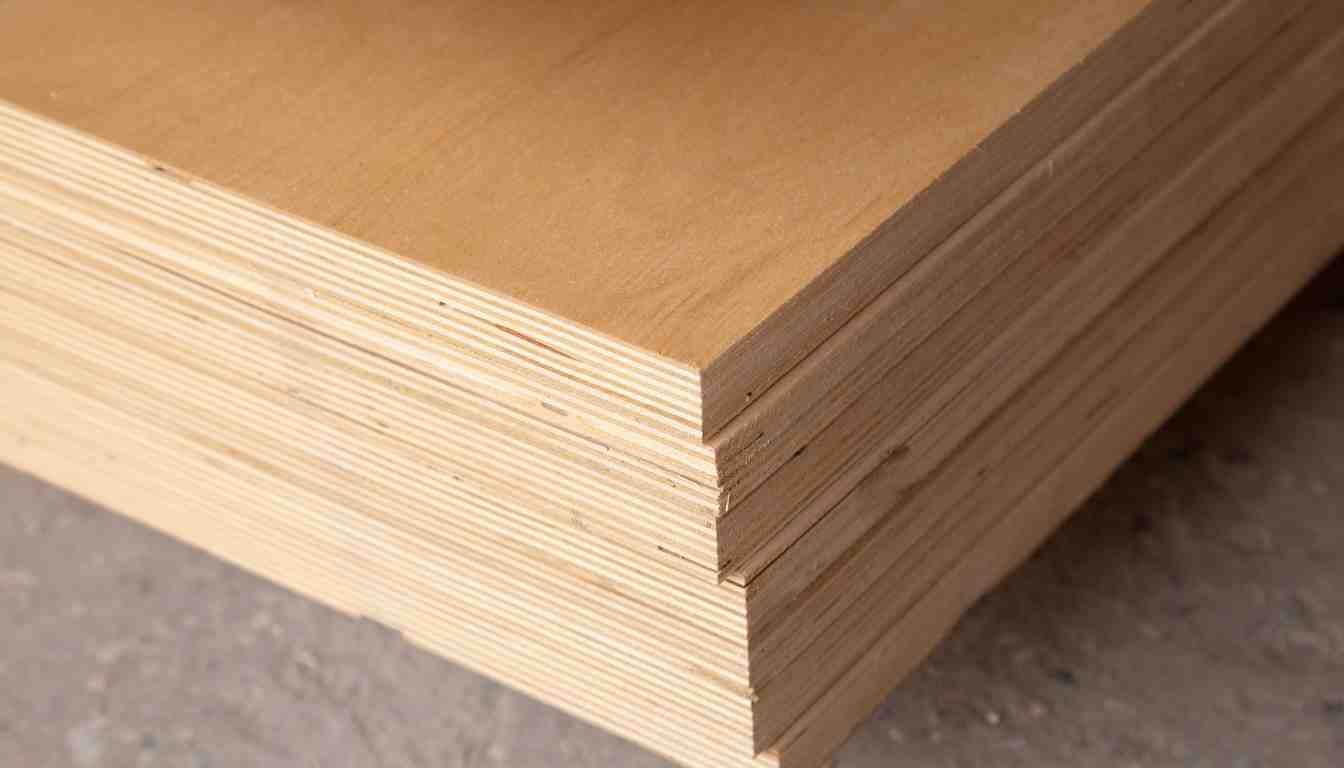Plywood is a type of engineered wood made from thin sheets of veneer. It is commonly used in construction and furniture making due to its strength and durability.
Plywood is known for its versatility, strength, and cost-effectiveness, making it a popular choice for various projects. When looking for a reliable building material, plywood is an excellent option due to its strength and durability. It is made by gluing thin layers of wood together, which results in a strong and stable product.
With its diverse applications in construction, furniture, and interior design, plywood offers a practical and cost-effective solution for many projects. Whether you’re building a house or creating custom furniture, plywood is a versatile and reliable material that can meet a wide range of needs.
The Basics Of Plywood
Plywood is a versatile and popular building material used in numerous construction and woodworking projects. It is a type of engineered wood made from thin layers of wood veneer, or “plies,” that are glued together. The cross-graining of the layers enhances the strength and stability of the material, making it ideal for a range of applications. Understanding the basics of plywood, including its composition and types, is essential for anyone working with wood or considering it for their projects.
What Is Plywood?
Plywood is made by gluing together layers of wood veneer, with each layer having its grain direction running perpendicular to the adjacent layer. This process is known as cross-graining and is what gives plywood its strength and durability. The number of layers used can vary, with more layers generally resulting in a stronger and stiffer plywood sheet. The most common type of plywood is constructed with an odd number of layers to ensure the sheet is balanced and stable.
Types Of Plywood
There are several types of plywood available, each designed for specific uses. Some of the most common types include:
- Softwood Plywood: Made from softwood veneers such as pine, cedar, or spruce. Ideal for structural applications and outdoor projects.
- Hardwood Plywood: Composed of hardwood veneers like oak, birch, or maple. Often used for furniture, cabinetry, and decorative finishes.
- Marine Plywood: Specially designed for use in areas exposed to moisture, such as boat building and outdoor construction.
- Birch Plywood: Known for its smooth surface and strength, making it suitable for high-end cabinetry and furniture.

Understanding Plywood Grades
Plywood grades categorize the quality of the wood, indicating its suitability for various applications.
Impact Of Grade On Quality
Plywood grades directly impact the strength and appearance of the final product.
Choosing The Right Plywood For Your Project
Choosing the right plywood is essential for any woodworking project. Whether you need it for construction or furniture making, selecting high-quality plywood ensures durability and long-lasting results. Understand your project requirements and choose plywood that matches the right grade, thickness, and wood type for optimal performance and aesthetics.
Plywood is a versatile material that finds application in a wide range of projects, from constructing furniture to building homes. However, to ensure the success of your project, it is essential to choose the right plywood. Consider the following factors when selecting plywood for your specific project and desired outcome.
Considerations For Specific Projects
Different projects require different types of plywood to achieve the desired results. Here are some considerations to keep in mind when selecting plywood for specific projects:
1. Furniture Construction: When building furniture, plywood with a high-quality finish and smooth surface is essential. Look for plywood with a hardwood veneer, as it offers greater durability and resistance to warping.
2. Cabinetry: For cabinets and storage units, consider using cabinet-grade plywood. This plywood is specially engineered to withstand heavy loads and frequent use. It is also available in various finishes to match your desired aesthetic.
3. Home Construction: Plywood plays a crucial role in home construction, providing the base for walls, roofs, and subfloors. Look for structural-grade plywood that meets industry standards and provides superior strength and stability.
4. Decorative Projects: If you are working on decorative projects like paneling or ceilings, decorative plywood can add a touch of elegance. This type of plywood features an attractive veneer on one or both sides, enhancing the aesthetics of your space.
Plywood For Different Environments
The environment in which your project will be located also affects the type of plywood you should choose. Here are considerations for different environments:
1. Interior: For projects that will be placed in a controlled interior environment, standard plywood is typically suitable. This type of plywood is cost-effective and readily available in different thicknesses and grades.
2. Exterior: Outdoor projects require plywood that can withstand weather conditions and moisture. Exterior-grade plywood is designed to resist moisture and decay, making it ideal for applications such as exterior walls and decks.
3. Humid Environments: In areas with high humidity levels, such as bathrooms and kitchens, moisture-resistant plywood should be used. This type of plywood is treated with chemicals or special adhesives to prevent damage caused by moisture.
Remember, choosing the right plywood for your project is essential to ensure longevity, durability, and success. By considering the specific requirements of your project and the environment in which it will be placed, you can make an informed decision when selecting plywood. So, take into account these factors and select plywood that suits your project’s needs perfectly.
| Project Type | Ideal Plywood |
|---|---|
| Furniture Construction | High-quality plywood with hardwood veneer |
| Cabinetry | Cabinet-grade plywood |
| Home Construction | Structural-grade plywood |
| Decorative Projects | Decorative plywood |
- Choose plywood based on the specific requirements of your project.
- Consider the location and environment where the project will be placed.
- For outdoor projects, use exterior-grade plywood to withstand weather conditions.
- In areas with high humidity, opt for moisture-resistant plywood.
- Ensure the plywood meets industry standards for strength and durability.
Working With Plywood: Tips And Techniques
When working with plywood, understanding essential tips and techniques can make your woodworking projects smoother and more efficient.
Cutting And Sizing Plywood
Accurate cutting and sizing are vital for a successful plywood project.
- Measure multiple times before cutting to avoid errors.
- Use a sharp blade to ensure clean and precise cuts.
- Support the plywood properly to prevent splintering and maintain safety.
Joining And Finishing Plywood
Joining plywood pieces enhances both structural integrity and aesthetics of your project.
- Select the right joining technique such as butt joints, dado joints, or rabbet joints.
- Apply wood glue evenly for a secure bond between plywood pieces.
- Sand the edges for a smooth finish and professional look.
Plywood Applications In Construction And Design
Structural Versus Non-structural Applications
Plywood is a versatile material widely used in various construction and design applications. It offers both structural and non-structural capabilities, making it an essential element in building projects of all sizes.
Innovative Design Uses
Designers and architects have pushed the boundaries of creativity by incorporating plywood in innovative ways across different projects. Its flexibility, durability, and aesthetic appeal have made it a favorite for unconventional designs and artistic endeavors.
Maintaining And Caring For Plywood
When caring for plywood, it is essential to keep it clean and dry, avoiding exposure to moisture and extreme temperatures. Regularly inspecting for any signs of damage and promptly addressing them can help maintain the quality and longevity of the plywood wood.
Maintaining and caring for plywood is essential to ensure its longevity and structural integrity. Protective coatings and finishes and preventive maintenance are crucial aspects of maintaining plywood. By following these guidelines, you can optimize the lifespan and performance of plywood in various applications.
Protective Coatings And Finishes
When using plywood for outdoor or high-moisture environments, applying a protective coating is vital. Sealants such as polyurethane or waterproofing finishes can provide a barrier against moisture, preventing warping and rot. Additionally, for indoor applications, applying a varnish or paint can enhance the aesthetic appeal and protect the surface from damage.
Preventive Maintenance
Regular cleaning is essential to prevent dirt and moisture buildup, which can lead to deterioration of the wood. Inspecting plywood for cracks, splits, or delamination is crucial to address any issues promptly. Moreover, maintaining a consistent humidity level in the surrounding environment can prevent swelling or shrinking of the plywood.
In conclusion, ensuring proper protective coatings and finishes, as well as implementing preventive maintenance measures, is essential for the upkeep of plywood. Adhering to these practices will prolong the life of plywood and maintain its structural integrity.
Environmental Considerations Of Plywood Usage
Sustainability And Responsible Sourcing
Plywood is a sustainable option due to its renewable nature and responsible sourcing practices.
Recycling And Disposal
Plywood can be recycled and repurposed, reducing waste and environmental impact.
:max_bytes(150000):strip_icc()/what-is-marine-grade-plywood-2736672-hero-4dc47a83bff842ccbc7718eaf6d6bb9e.jpg)
Credit: www.thespruce.com
Frequently Asked Questions On Plywood Wood
What Are The Different Grades Of Plywood Available?
Plywood grades include A, B, C, and D, with A being the highest quality. Grades determine appearance and quality.
How To Choose The Right Plywood For Your Project?
Consider factors like intended use, budget, and aesthetics when selecting plywood for a project to ensure durability and aesthetics.
What Are The Advantages Of Using Plywood Over Other Materials?
Plywood is strong, versatile, and cost-effective, making it ideal for various projects from furniture to construction.
Can Plywood Be Used For Outdoor Projects?
Yes, certain types of plywood are treated to withstand outdoor conditions including moisture and temperature fluctuations. It’s important to choose the right type of plywood for outdoor use.
Conclusion
The versatility and durability of plywood make it a top choice for various projects. The cost-effective yet strong nature of plywood can elevate any construction or DIY undertaking. By understanding its characteristics and uses, you can leverage plywood to enhance your next creative endeavor.


